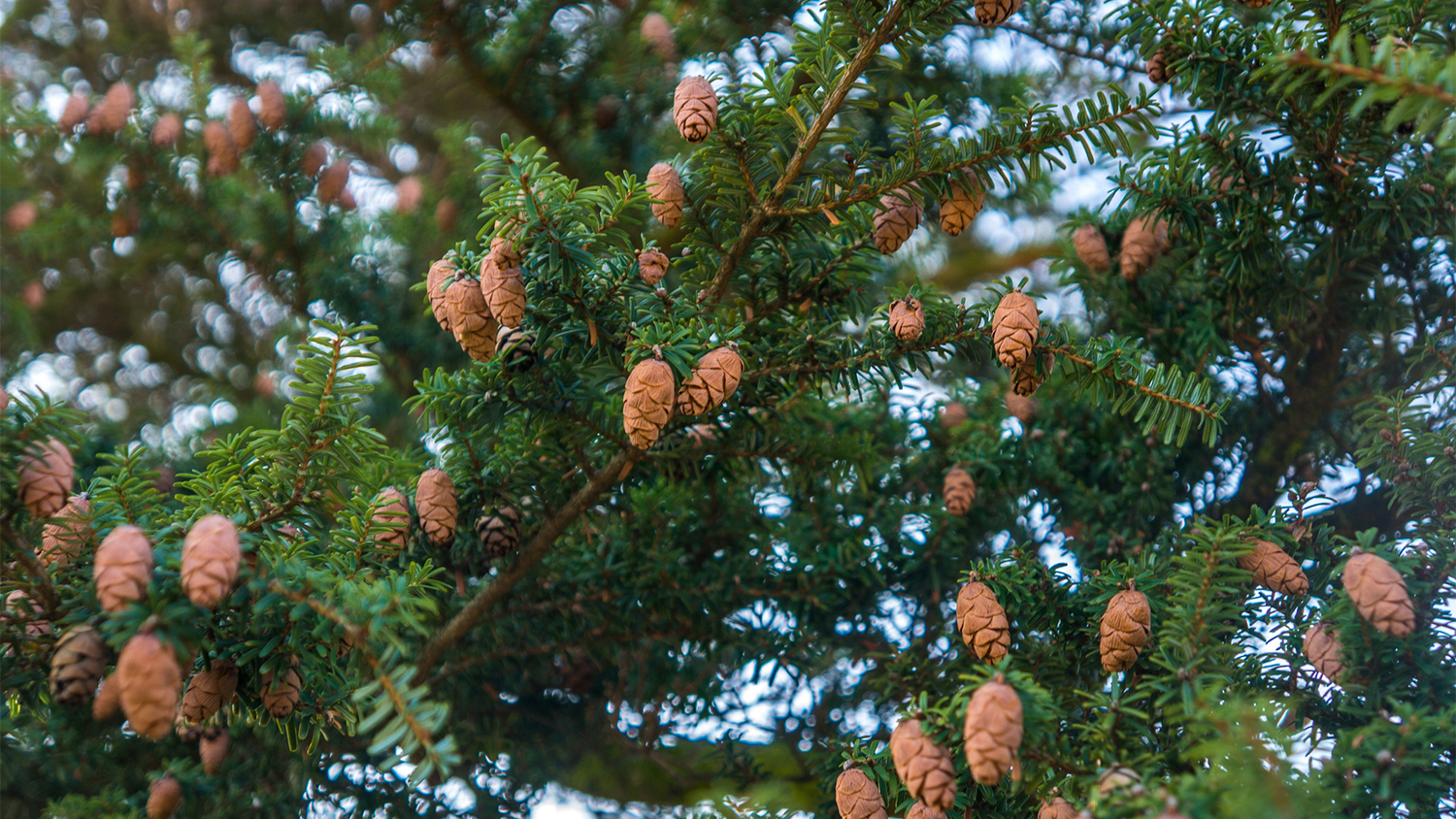A New Hope for the Eastern Hemlock
Researchers at NC State's College of Natural Resources are developing a new tool to prevent hemlock woolly adelgid infestations.

Emily Dickinson once wrote about the hemlock tree’s magnificence: “How the hemlocks are tipped in tinsel by the wizard sun.” Today, hemlocks remain a splendor of nature. But they’re also dying in large numbers from an invasive pest. That’s why NC State researchers like Robert Jetton are working to improve the species’ health and sustainability.
“Hemlock is very important to the ecosystem. It’s a keystone species. So when you remove it, the ecosystem changes at a basic level,” said Jetton, a research associate professor in the Department of Forestry and Environmental Resources at the College of Natural Resources and forest health specialist for Camcore. “Reintroducing hemlock may not be as simple as going out and planting some seedlings .”
To help save the hemlock, Jetton and his colleagues are studying 105 eastern hemlock trees from western Maryland to eastern Tennessee and north Georgia. In eastern North America, there are two species of hemlock: eastern hemlock and Carolina hemlock.
The eastern hemlock resides in a large area that extends from the southern Appalachian Mountains to southern Canada and then into the Great Lakes states of Michigan, Wisconsin and a portion of Minnesota. The Carolina hemlock can only be found in the southern Appalachians, with most of its populations occurring in western North Carolina.
Jetton’s research focuses on finding management strategies for the invasive hemlock woolly adelgid (HWA). This tiny sap-sucking insect is causing the widespread death of hemlock trees in the eastern United States. More than half of the eastern hemlock population is infested, and trees have been dying rapidly. The hemlock woolly adelgid, which is native to eastern Asia and the Pacific Northwest, was likely introduced to the U.S. in the early 20th century. In 1951, the insect was discovered in Richmond, Virginia. It has since spread across the eastern U.S.
Jetton’s research aims to develop a silvicultural tool forest managers can use, along with other strategies, to improve the hemlock’s health. The U.S. Forest Service defines silviculture as “the art and science of controlling the establishment, growth, composition, health, and quality of forests and woodlands to meet the diverse needs and values of landowners and society such as wildlife habitat, timber, water resources, restoration and recreation on a sustainable basis.”
While eastern hemlock is rapidly dying, Jetton believes that the species will not go extinct. “There are a lot of people saying that hemlocks will go extinct. While they may become functionally extinct in certain areas, I don’t think we’re looking at a true numerical extinction of the species. A similar insect impacted Fraser fir in the southern Appalachian Mountains during the mid-1900s, and we still have Fraser fir out there. In fact, it’s rebounding to a large degree. There’s a lot of hope for hemlock.”

“We regularly see trees that exist in higher sunlight conditions and tend to survive HWA infestation for longer periods of time. However, increased sunlight is not a silver bullet. It doesn’t permanently protect the tree,” Jetton said. “Eventually, trees with increased sunlight will succumb to the adelgid, but they do survive longer than those under more dense shade.”
When Jetton and his colleagues increased sunlight exposure on potted hemlock seedlings as a precursor to taking his research out in the field, the hemlock woolly adelgid populations decreased significantly. A follow-up field study revealed that after removing surrounding trees and creating a large gap for sunlight around a small number of trees in the forest, adelgid populations started to decline for the first two years. On control trees living in more shaded conditions, the adelgid experienced population growth. Trees growing in gaps grew nine times more than trees in shaded conditions, with increased shoot and annual basal area growth.
The importance of the hemlock
Both Jetton and his colleague Albert “Bud” Mayfield from the U.S. Forest Service’s Southern Research Station in Asheville, North Carolina, are passionate about conserving and restoring the hemlock.
“Restoring hemlock is about more than just returning the tree to the landscape,” said Mayfield. “It’s about restoring the type of ecosystem that hemlocks largely define.”
In the forest, hemlock is deemed a foundational species — the forest is where the species dominates, and it tends to dictate what other kinds of species will occur in the surrounding ecosystem. In the southern Appalachian Mountains, hemlocks primarily grow along streams where there are various species of fish, salamanders and aquatic invertebrates.
Once hemlock is removed from a streamside ecosystem, changes in stream temperature occur, along with water chemistry changes. This causes negative impacts on the ecosystem and causes concern for stream biodiversity in areas where the hemlock dominates. Wild turkey and deer also use hemlock significantly — they seek out the species for its leaves, twigs and buds to create bedding. Neotropical birds seek out hemlock forests for roosting sites and some choose to roost in hemlock during their migration season.
A new silviculture tool save the hemlock
Jetton said he hopes his research efforts result in a silvicultural tool that is part of the overall forest integrated pest management strategy to manage the adelgid population.
“We’re not after a silver bullet,” he added. “The adelgid problem will require a suite of forest management tools: The silviculture tool combined with insecticides, biocontrol agents, and perhaps adelgid-resistance breeding.”
While insecticides may not be the most desirable solution, they remain a very effective tool. On their own, they serve as the primary tool foresters currently have to ultimately protect hemlocks from hemlock woolly adelgid.
The management strategies being explored by Jetton are very much in the developmental stage. He and his colleagues have singled out individual hemlock trees in the forest and removed some of the surrounding trees to increase sunlight exposure. They are also studying the effect that creating these large gaps has on the pollinator community in the forest and monitoring if increased sunlight exposure in a forest allows more opportunities for invasive plants to establish.
Jetton is especially curious to discover if a condition can be created where the hemlock woolly adelgid is regulated at a low, stable population level and can still feed on the tree. At the same time, the hemlock would be able to outgrow the insects’ impact and better tolerate the infestation. However, it’s possible that the tree and its growth starts to decline again.
“That would be disappointing, but it would show that we provided a short-term window for the first few years where adelgid populations decreased while carbon balance and growth of the trees improved. That’s the window of opportunity we might need to get adelgid predators established or get other management into the forest to help conserve those trees on the landscape,” Jetton said.
He added, “Our end goal is to have a stand-level prescription that foresters can take out and utilize as part of their management strategy. Exactly what the prescription will be will likely be different for the southern Appalachians versus New England or the upper Midwest. Hemlocks grow in different forest types in those regions. We need to eventually start testing this out across a larger number of areas.”


